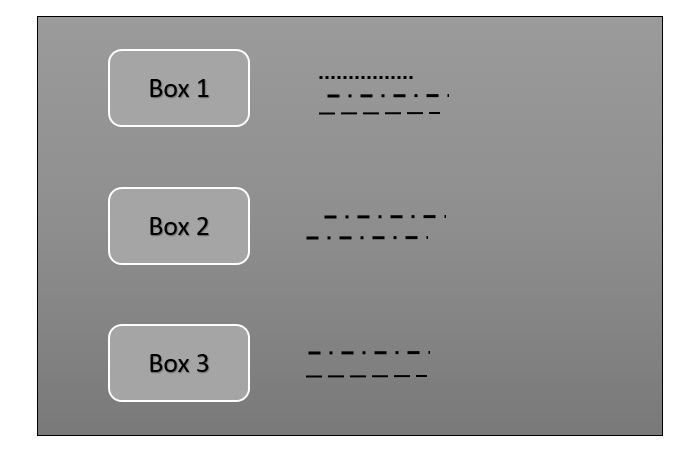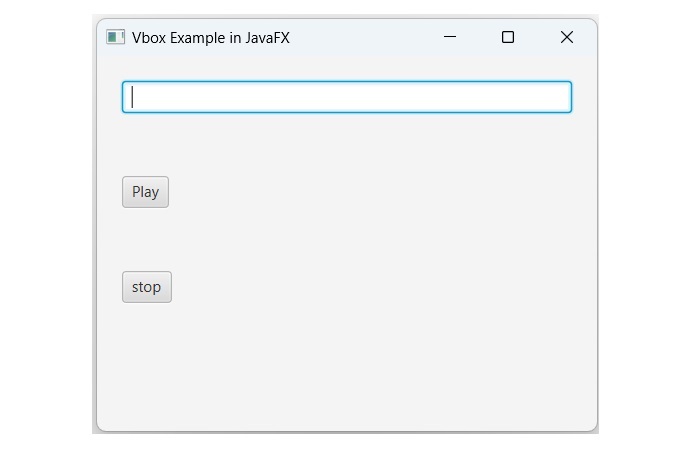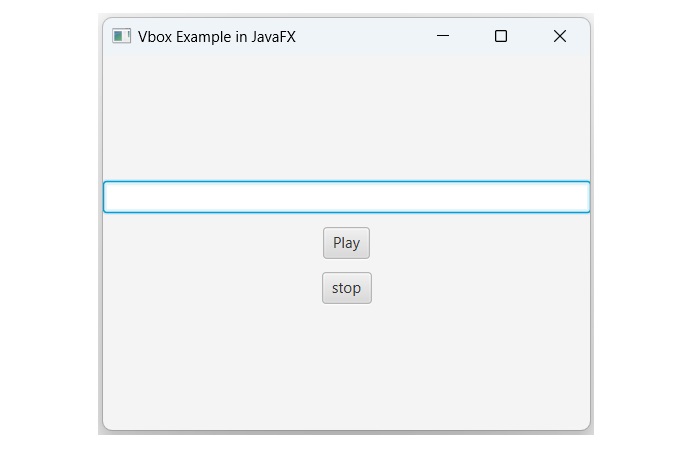
- JavaFX Tutorial
- JavaFX - Home
- JavaFX - Overview
- JavaFX Installation and Architecture
- JavaFX - Installation Using Netbeans
- JavaFX - Installation Using Eclipse
- JavaFX - Installation using Visual Studio Code
- JavaFX - Architecture
- JavaFX - Application
- JavaFX 2D Shapes
- JavaFX - 2D Shapes
- JavaFX - Drawing a Line
- JavaFX - Drawing a Rectangle
- JavaFX - Drawing a Rounded Rectangle
- JavaFX - Drawing a Circle
- JavaFX - Drawing an Ellipse
- JavaFX - Drawing a Polygon
- JavaFX - Drawing a Polyline
- JavaFX - Drawing a Cubic Curve
- JavaFX - Drawing a Quad Curve
- JavaFX - Drawing an Arc
- JavaFX - Drawing an SVGPath
- JavaFX Properties of 2D Objects
- JavaFX - Stroke Type Property
- JavaFX - Stroke Width Property
- JavaFX - Stroke Fill Property
- JavaFX - Stroke Property
- JavaFX - Stroke Line Join Property
- JavaFX - Stroke Miter Limit Property
- JavaFX - Stroke Line Cap Property
- JavaFX - Smooth Property
- Operations on 2D Objects
- JavaFX - 2D Shapes Operations
- JavaFX - Union Operation
- JavaFX - Intersection Operation
- JavaFX - Subtraction Operation
- JavaFX Color and Texture
- JavaFX - Colors
- JavaFX Text
- JavaFX - Text
- JavaFX Effects
- JavaFX - Effects
- JavaFX Transformations
- JavaFX - Transformations
- JavaFX Animations
- JavaFX - Animations
- JavaFX Images
- JavaFX - Images
- JavaFX 3D Shapes
- JavaFX - 3D Shapes
- JavaFX - Creating a Box
- JavaFX - Creating a Cylinder
- JavaFX - Creating a Sphere
- Properties of 3D Objects
- JavaFX - Cull Face Property
- JavaFX - Drawing Modes Property
- JavaFX - Material Property
- JavaFX Event Handling
- JavaFX - Event Handling
- JavaFX - Using Convenience Methods
- JavaFX - Event Filters
- JavaFX - Event Handlers
- JavaFX UI Controls
- JavaFX - UI Controls
- JavaFX - ListView
- JavaFX - Accordion
- JavaFX - ButtonBar
- JavaFX - ChoiceBox
- JavaFX - HTMLEditor
- JavaFX - MenuBar
- JavaFX - Pagination
- JavaFX - ProgressIndicator
- JavaFX - ScrollPane
- JavaFX - Separator
- JavaFX - Slider
- JavaFX - Spinner
- JavaFX - SplitPane
- JavaFX - TableView
- JavaFX - TabPane
- JavaFX - ToolBar
- JavaFX - TreeView
- JavaFX - Label
- JavaFX - CheckBox
- JavaFX - RadioButton
- JavaFX - TextField
- JavaFX - PasswordField
- JavaFX - FileChooser
- JavaFX - Hyperlink
- JavaFX - Tooltip
- JavaFX - Alert
- JavaFX - DatePicker
- JavaFX - TextArea
- JavaFX Charts
- JavaFX - Charts
- JavaFX - Creating Pie Chart
- JavaFX - Creating Line Chart
- JavaFX - Creating Area Chart
- JavaFX - Creating Bar Chart
- JavaFX - Creating Bubble Chart
- JavaFX - Creating Scatter Chart
- JavaFX - Creating Stacked Area Chart
- JavaFX - Creating Stacked Bar Chart
- JavaFX Layout Panes
- JavaFX - Layout Panes
- JavaFX - HBox Layout
- JavaFX - VBox Layout
- JavaFX - BorderPane Layout
- JavaFX - StackPane Layout
- JavaFX - TextFlow Layout
- JavaFX - AnchorPane Layout
- JavaFX - TilePane Layout
- JavaFX - GridPane Layout
- JavaFX - FlowPane Layout
- JavaFX CSS
- JavaFX - CSS
- Media with JavaFX
- JavaFX - Playing Video
- JavaFX Useful Resources
- JavaFX - Quick Guide
- JavaFX - Useful Resources
- JavaFX - Discussion
JavaFX - VBox Layout
VBox Layout in JavaFX
VBox which is also known as Vertical Box, is a layout control that arranges all the nodes of a JavaFX application in a single vertical column. The VBox layout pane is represented by a class named VBox of the package javafx.scene.layout. Instantiating this class will create an VBox layout. List of constructors of this class is as follows −
VBox() − It is the default constructor that constructs an VBox layout with 0 spacing.
VBox(double spacingVal) − It constructs a new VBox layout with the specified spacing between nodes.
VBox(double spacingVal, Node nodes) − This parameterized constructor of VBox class accepts children nodes as well as spacing between them and creates a new VBox layout with the specified components.
VBox(Node nodes) − It creates an VBox layout with specified children nodes and 0 spacing.
The figure below shows three boxes positioned in a vertical layout −

The VBox class comes with several pre-defined properties which are listed below −
alignment − This property represents the alignment of the nodes inside the bounds of the VBox. You can set value to this property by using the setter method setAlignment().
fillHeight − This property is of Boolean type and on setting this to be true; the resizable nodes in the VBox are resized to the height of the VBox. You can set value to this property using the setter method setFillHeight().
spacing − This property is of double type and it represents the space between the children of the VBox. You can set value to this property using the setter method setSpacing().
padding − It represents the space between the border of VBox and its child nodes. We can set value to this property using the setter method setPadding() which accepts Insets constructor as a parameter value.
In addition to these, this class also provides the following methods −
| S.No | methods & Description |
|---|---|
| 1 | setVgrow()
Sets the vertical grow priority for the child when contained by a VBox. This method accepts a node and a priority value. |
| 2 | setMargin()
Using this method, you can set margins to the VBox. This method accepts a node and an object of the Insets class (A set of inside offsets for the 4 sides of a rectangular area). |
Example
The following program is an example of the VBox layout. In this, we are inserting a text field and two buttons namely play and stop. Save this code in a file with the name VBoxExample.java.
import javafx.application.Application;
import javafx.geometry.Insets;
import javafx.scene.Scene;
import javafx.scene.control.Button;
import javafx.scene.control.TextField;
import javafx.stage.Stage;
import javafx.scene.layout.VBox;
public class VBoxExample extends Application {
@Override
public void start(Stage stage) {
//creating a text field
TextField textField = new TextField();
//Creating the play button
Button playButton = new Button("Play");
//Creating the stop button
Button stopButton = new Button("stop");
//Instantiating the VBox class
VBox box = new VBox();
//Setting the space between the nodes of a HBox pane
box.setSpacing(10);
//Adding all the nodes to the VBox
box.getChildren().addAll(textField, playButton, stopButton);
//Setting the margin to the nodes
box.setMargin(textField, new Insets(20, 20, 20, 20));
box.setMargin(playButton, new Insets(20, 20, 20, 20));
box.setMargin(stopButton, new Insets(20, 20, 20, 20));
//Creating a scene object
Scene scene = new Scene(box, 400, 300);
//Setting title to the Stage
stage.setTitle("Vbox Example in JavaFX");
//Adding scene to the stage
stage.setScene(scene);
//Displaying the contents of the stage
stage.show();
}
public static void main(String args[]){
launch(args);
}
}
Compile and execute the saved java file from the command prompt using the following commands.
javac --module-path %PATH_TO_FX% --add-modules javafx.controls VBoxExample.java java --module-path %PATH_TO_FX% --add-modules javafx.controls VBoxExample
Output
On executing, the above program generates a JavaFX window as shown below.

Example
In this example, we will use the parameterized constructor of the VBox class to create a vertical layout. Save this code in a file with the name VBoxExample.java.
import javafx.application.Application;
import javafx.geometry.Pos;
import javafx.scene.Scene;
import javafx.scene.control.Button;
import javafx.scene.control.TextField;
import javafx.stage.Stage;
import javafx.scene.layout.VBox;
public class VBoxExample extends Application {
@Override
public void start(Stage stage) {
//creating a text field
TextField textField = new TextField();
//Creating the play button
Button playButton = new Button("Play");
//Creating the stop button
Button stopButton = new Button("stop");
//Instantiating the VBox class
VBox box = new VBox(10, textField, playButton, stopButton);
box.setAlignment(Pos.CENTER);
//Creating a scene object
Scene scene = new Scene(box, 400, 300);
//Setting title to the Stage
stage.setTitle("Vbox Example in JavaFX");
//Adding scene to the stage
stage.setScene(scene);
//Displaying the contents of the stage
stage.show();
}
public static void main(String args[]){
launch(args);
}
}
Compile and execute the saved java file from the command prompt using the following commands.
javac --module-path %PATH_TO_FX% --add-modules javafx.controls VBoxExample.java java --module-path %PATH_TO_FX% --add-modules javafx.controls VBoxExample
Output
On executing, the above program generates the following output.
